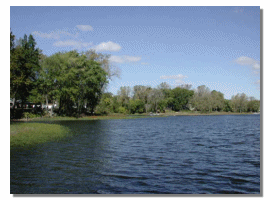Stormwater Division
 Office Hours:
Office Hours:
Monday - Friday: 7:00 a.m. to 3:30 p.m.
Telephone: (352) 551-6503
Office Location:
300 W. Pearl Street
Minneola, FL 34715
The Environmental Protection Agency (EPA) has delegated responsibility to the Florida Department of Environmental Protection (DEP) to implement the National Pollutant Discharge and Elimination System (NPDES) of the Clean Water Act. The NPDES regulates local point source and non-point source discharges of stormwater runoff into surface water. Stormwater Pollution Prevention Guide
All municipalities and counties were required to obtain a NPDES permit from DEP on or before 2004, and develop/implement a stormwater management program that includes the best management practices (BMP's) with measurable goals.
The City of Minneola currently has an active NPDES permit #FLR04E111 and a stormwater management program with restrictive rules on development runoff controls and pollution prevention. The City also provides regular street sweeping and a stormwater retrofit program funded through its existing stormwater utility fees.
Information about the U.S. Environmental Protection Agency's National Pollutant Discharge and Elimination System (NPDES) can be found at: http://cfpub.epa.gov/npdes/index.cfm
The Water Quality Sampling Database is designed to allow you to search for information by watershed, county and water body and to determine levels of dissolved oxygen, pH and chemicals in the water's makeup. This site is update as information is gathered and can be found at: secure.sjrwmd.com/aqportal/Data
Stormwater runoff, a critical pollutant carrier, generally discharges into the surface water of lakes and canals in Lake County. These pollutants consist of oil, heavy metals, pesticides, herbicides, and fertilizers originating from Lawns, vehicles, and septic tanks. The quality of our environment and the recreation value of all lakes and rivers decreases over the years which has resulted in federal and state government regulations to reduce and possibly eliminate some of the adverse environmental impacts of pollutants in our daily lives.
One of our concerns is educating the public on the importance of the swales that are in many front yards throughout the City and the stormwater inlets. A swale is a wide shallow ditch that has been dug along the street and sometimes beside and behind the property. Swales are used to convey stormwater and to help treat runoff, reducing pollutants that reach our lakes, streams and underground water supply. When land is developed, the volume, speed of flow, and pollutants increase. Swales reduce the waters speed and allow vegetation to filter the rainwater and remove sediments.
It is very important that you do not fill in the swale with dirt, rocks , trees, etc. If you fill the swale , you have greater chance of flooding occurring a heavy rain. Other ways to maintain your swale: remove leaves and grass clippings; keep good grass growth; minimize the use of fertilizers, pesticides and herbicides. Do not pile garbage, trash, leaves, or limbs in your swale. Do not park vehicles in the swale; this compacts the soil so less runoff soaks in.
Inlets: Stormwater inlets are the concrete drains that you see along the streets. These drains are used to convey stormwater to prevent flooding of the streets, business and homes. If these drains become full of yard debris or other garbage, they do not work properly.
Please do not blow yard clippings and leaves in the roadway. These items wash down the streets and into the stormwater drains where they plug the system allowing streets, homes, and business to flood. Do not dump any type of oil, gasses, antifreeze, household chemicals, BBQ grill briquettes, etc. into the drain or onto the side of the road where they will wash/run down into the drains. This adds to the pollutants in the waterways.
Florida Yards & Neighborhoods - Protecting Florida's Natural Resources
Through Environmentally Friendly Landscaping and Lawncare
10 things you can do to prevent stormwater pollution
National Pollutant Discharge Elimination System (NPDES)
Best Management Practices (BMP’s)
- Public Education and Outreach
Public Participation / Involvement
Illicit Discharge Detection and Elimination
Construction Site Runoff Control
Post-Construction Runoff Control
Pollution Prevention / Good Housekeeping
Links
Note: All links below open documents in .pdf format.
General Construction Solution to Pollution Pamphlet

